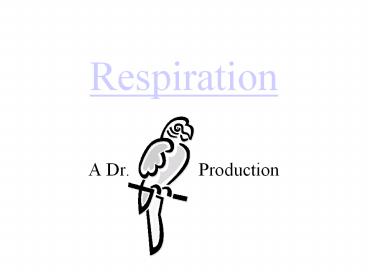Respiration - PowerPoint PPT Presentation
1 / 25
Title:
Respiration
Description:
Respiration A Dr. Production Energy Concepts Thermodynamics & Reaction Rates RESPIRATION a process where organic (food) molecules are oxidized & broken down to ... – PowerPoint PPT presentation
Number of Views:39
Avg rating:3.0/5.0
Title: Respiration
1
Respiration
- A Dr. Production
2
Energy Concepts
- Thermodynamics Reaction Rates
3
- RESPIRATION ? a process where organic (food)
molecules are oxidized broken down to release E - Glycolysis is the 1o source of e- for the citric
acid and e- transport chain - CH2O O2 ? CO2 H2O Energy
- Has both an anaerobic phase and an aerobic phase
- Associated with Mitochondria found in eukaryotic
cells
4
- Respiration is a multi-step process that occurs
in several places in the mitochondria. So it is
important that you know the anatomy of the
mitochondria
5
- Glyco lysis, or "splitting of sugar" occurs in
the cytosol - Glucose is very stable, and must be converted to
reactive compound by phosphorylation - Glucose (6C) 2ATP
- 2ADP 2P
- PGAL (3C) PGAL (3C)
- NAD NAD
- NADH NADH
- 2ADP 2P 2ADP 2P
- 2ATP 2ATP
- Pyruvic Acid (3C) Pyruvic Acid (3C)
6
Redox Reactions
- How NAD Works
7
Glycolysis
- net gain 2ATP, 2 total E in 1 molecule glucose,
only 7 of E released - 2ADP ? 2ATP
- 2NAD ? 2NADH 2H
- 1 Glucose ? 2Pyruvate
8
Pyruvic Acid vs Pyruvate
? Draw pyruvate
9
Conversion of Pyruvate
- Conversion of Pyruvate occurs in the
mitochondrial membrane
? Identify the components of Acetyl CoA
10
TCA/Citric Acid/Krebs Cycle
- Citric Acid Cycle occurs in the mitochondrial
matrix - each molecule acetyl Co-A yields the following
from one molecule of glucose - 3NADH H
- 1FADH2
- 1ATP
- 2CO2
11
Or, for a more detailed look
12
The Electron Transport Chain
- E- Transport Chain occurs across the inner
mitochondrial membrane and in the inter-membrane
space - It uses O2 to transfer e- from 10NADH H and
2FADH2 - It separates H into e- and H, carries e- away
from H gradient
13
Which side is more basic than the other? More
acidic? More alkaline?
14
- ATPase attached to H channels and uses kinetic
E of H to join ADP P this is called
"chemiosmotic ATP synthesis" - each NADH H produces 3ATP 30 ATP
- each FADH2 produces 2ATP 4 ATP
- Glycolysis 2 ATP
- Krebs Cycle 2 ATP
ATP Synthetase The Movie
15
Electron Transporters
16
Got O2?
- In the absence of O2
- Fermentation occurs
17
- Pyruvate (3C) Pyruvate (3C)
- CO2
- Acetaldehyde (2C)
- NADH H NADH H
- NAD NAD
- Ethanol Lactic Acid
- Liver
- Glucose
Glycogen in the liver is a reserve of glucose.
When blood sugar levels drop below 4 to 5 mM
glycogen phosphorylase is activated
18
(No Transcript)
19
(No Transcript)
20
- Fermentation generates 0ATP, so what is its
usefulness? - How did the first anaerobic heterotrophs make E?
- NAD is needed for glycolysis
- Pyruvic acid generates NADH from NAD,
fermentation regenerates NAD - Which is more efficient, aerobic or anaerobic
respiration? What is the evolutionary
significance of this?
21
Alternative Energy Sources for Muscles
- Hydrolysis of Sucrose in Intestines
- Fatty Acid Metabolism
22
RESPIRATION
CYTOPLASM GLYCOLOSIS HAPPENS HERE!
PROTEINS
CARBOS (SUGARS)
FATS (LIPIDS)
GLUCOSE C6H12O6
AMINO ACIDS
MAKES 2 ATPS
GLYCOLOSIS IN CYTOPLASM NO OXYGEN!
PYRUVIC ACID
ATP TOTALS GLYCOLOSIS2 RESPIRATION34 BOTH36!
CO2 IS RELEASED
ACETYL-CoA
O2 ENTERS HERE
KREBS CYCLE AND ELECTRON TANSPORT
MAKES 34 ATPS
MITOCHONDRIA RESPIRATION HAPPENS IN THIS
ORGANELLE!
23
Gluconeogenesis
- Gluconeogenesis is the synthesis of glucose from
non-carbohydrate sources. Glucose must be
synthesized after 12-24 hours of fasting or
during prolonged exercise to maintain blood
glucose concentration. - The brain prefers to use glucose as fuel,
although after a long period of starvation it can
derive some of its energy requirements from
ketone bodies.
- RBCs have an absolute requirement for glucose
since they have no mitochondria and can not
utilize ketone bodies. - Occurs in the liver ( kidney cortex after
prolonged starvation), in cytosol mitochondria.
24
Glycolysis Pyruvate Intermediate TCA Cycle E- Transport Chain Fermen-tation
Where it occurs
Co-Enzymes used
Co-Enzymes produced
ATP Used
ATP Produced
MISC Inputs
MISC Outputs
25
References
- Hibernation
- Krebs cycle Tutorial
- Citric Acid Cycle tutorial
- AP Animations Quizzes
- ATP Energy Storage
- Fermentation Irritable Bowel Syndrome
- Step by Step Glycolysis
- Interactive Biochemistry Animations
- Overview of Glycolysis Heavy Chemistry
- Fundamentals of Biochemistry Animations
- Glycolysis with Redox Reactions
- Cellular Respiration Animation Summary































